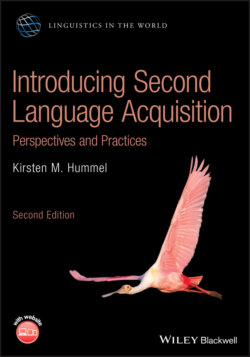Читать книгу Introducing Second Language Acquisition - Kirsten M. Hummel - Страница 40
Exercises continued
Оглавление1 Use the same transcript as for Exercise 1, or choose a different CHILDES transcript, to examine the type of language used by adults when speaking to a child. What type of utterances tend to characterize the adult's speech? Do they differ from how adults speak to other adults?
2 Arrange to observe the interactions between a young child and a parent/caretaker in his or her environment. Record the child's and caretaker's utterances. Next, observe an older child or adult as he or she communicates in an L2 with a native speaker of the target language and record these interactions. Compare the type of language (types and length of sentences, types of words, repetition, etc.) used by the caretaker and native speaker with the young L1 learner and the older L2 learner. Is the type of language used different in each case? How so? What other differences do you find in the two sets of data?
3 Observe/tape record children speaking to each other and attempt to identify instances of overgeneralization, i.e. using rules and structures in contexts or instances in which they should not be used (example: “My arm hurted a lot.”).
4 Interview parents of young children and ask them what the first words to appear were. Compare your results from the different families. To what extent are the types of first words similar or not? If possible, also interview parents who speak languages other than English to their children. Are similar types of words reported in those families?
5 Read the article by Jean Berko on her study using the Wug test (available via the CHILDES website). If you have access to a young child (four to seven years old), prepare “Wug” drawings and test the child's ability to generalize morphological rules to invented words, as done in her study. Do you find similar results? If not, can you offer any reasons why?
